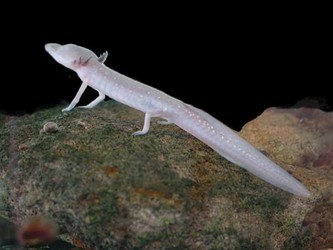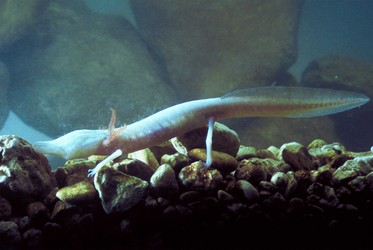Today was just another ordinary day for the Boris the Texas Blind Salamander. He got up from bed and swam around his cave. Although, Boris was not too sure where he was because he is blind because of his adaptation. He knew he was underwater, it was cold, it was rocky and it was very dark. Boris is an amphibian with a long tail, and short feet. Boris also has very strange skin. Boris' skin is almost transparent due to the lack of pigment in the blind salamanders' skin as they live in the dark waters of caves. Boris is blind because he has no use for eyes because it is so dark. Boris' most obvious feature is his bright red gills that protrude from the sides of his head. Boris is a proud four inches long.
Boris' stomach was rumbeling because it had been over a month since he had eaten. Boris swam over to his favorite feeding rock. He waited patiently for for a shrimp or small snail to come along. These were his favourite foods. Boris hunts by sensing water pressure waves created by prey in the still underground waters where he lives. Over a month later a small snail came along and Boris thought to himself, "mmm... here comes some nice french cuisine coming my way. I feel like having some escargot today!" Boris quickly snached the snail and devoured it.


A Texas Blind Salamander, Eurycea rathbuni, perched on a rock waiting for food. Photo courtesy Joe N. Fries, U.S. Fish and Wildlife Service.
Boris is a very difficult salamander to get a hold of because his kind is only found in one place in the entire world along with forty other unique creatures. Boris lives in a place called the Edwards Aquifer, which is a groundwater system, and an artesian aquifer in the state of Texas in the United States. He lives in the dark, cold, fast flowing waters of this cave crawling over rocks waiting for food to come its way living without the usual light and cues that are experienced by other creatures on land.
After Boris was done with his delicious meal of snail, he went on the prowl to find a mate for the night. Unlike most animals, the Texas Blind Salamander is not a cyclic breeder. Boris will mate at anytime of the year. Boris searched his cave and stumbled onto another salamander. Her name was Tina. Before reproducing Tina must engage in foreplay. She did this by rubbing her chin on Boris. She also fanned her tail which releases pheromones arounding Boris. Excitedly, Boris then left a packet of sperm, a spermatophore, on a rock for Tina to collect.


Eurycea rathbuni swimming. Photo by Glenn Longly/USFWS
Boris then headed back to his resting rock to lie down for another few days. Boris is now looking for a roommate to hangout with him back at his rock. Unfortunately, there are not very many other salamanders around. This was just another day in the life of this Texas Blind Salamander.
Information on the Internet
- Eurycea rathbuni DigiMorph Staff. 2004. Digital Morphology. Accessed September 16, 2008
- Eurycea rathbuni Munger, M. 2000. Animal Diversity Web. Accessed September 16, 2008



 Go to quick links
Go to quick search
Go to navigation for this section of the ToL site
Go to detailed links for the ToL site
Go to quick links
Go to quick search
Go to navigation for this section of the ToL site
Go to detailed links for the ToL site